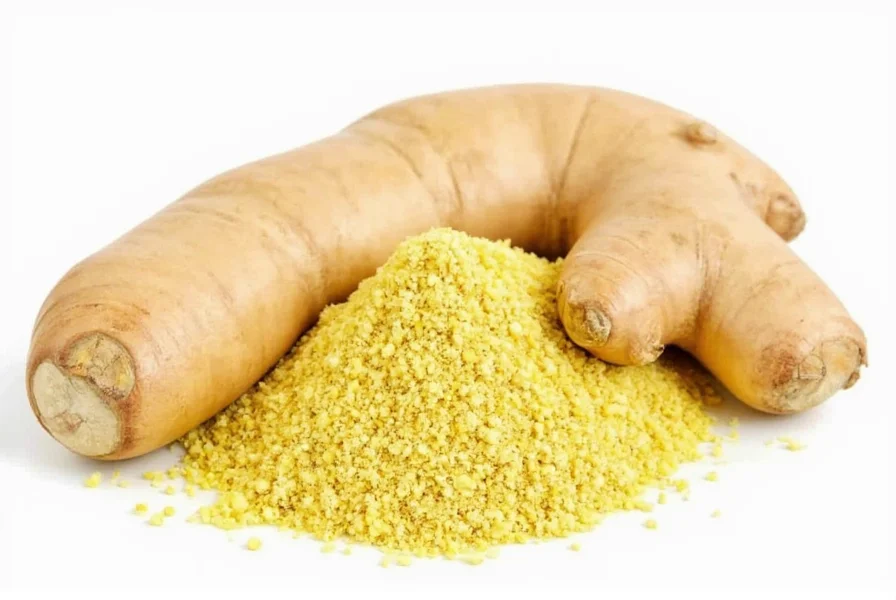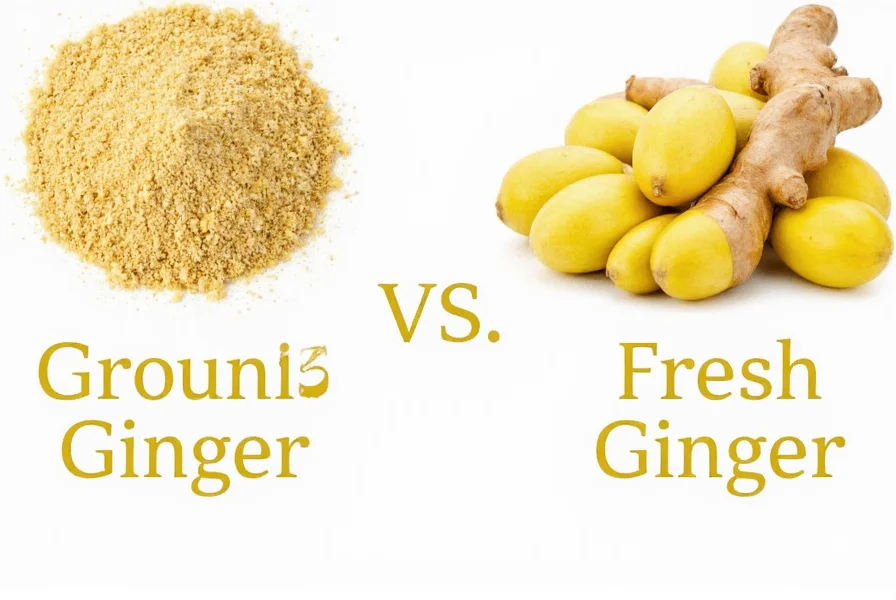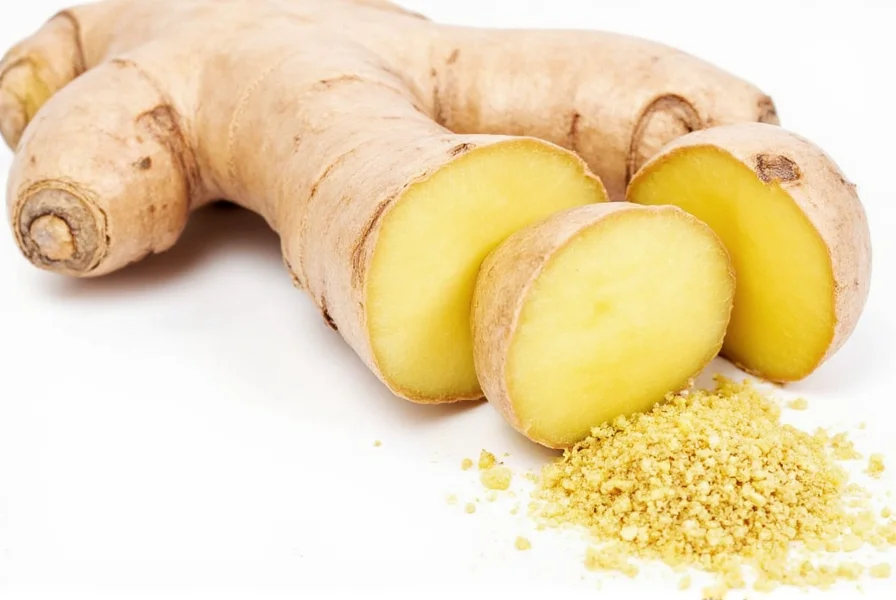Understanding the proper ground ginger to fresh ginger ratio is essential for achieving balanced flavors in your cooking and baking. Many home chefs find themselves needing to substitute one form for the other when a recipe calls for a specific type they don't have on hand. Getting this conversion wrong can result in dishes that are either too bland or overwhelmingly spicy.
Why the Ratio Isn't 1:1
The reason ground ginger and fresh ginger aren't interchangeable in equal amounts comes down to moisture content and concentration. Fresh ginger contains about 70% water, while ground ginger has been dried and concentrated. When ginger is dried and ground, its flavor compounds become more potent, requiring less quantity to achieve similar flavor intensity.
This concentration difference explains why you need significantly less ground ginger than fresh when substituting. Using equal amounts would result in an overpowering, sometimes bitter flavor that dominates your dish.
| Measurement | Ground Ginger | Fresh Ginger |
|---|---|---|
| Standard Ratio | 1/4 teaspoon | 1 tablespoon (3 teaspoons) |
| For 1 inch fresh ginger | 1/2 teaspoon | 1 inch knob (about 1 tablespoon grated) |
| For 1/4 cup fresh ginger | 1 teaspoon | 1/4 cup grated |
Factors That Affect the Conversion Ratio
While the standard ground ginger to fresh ginger ratio provides a reliable starting point, several factors can influence how you might adjust this conversion:
- Freshness of ingredients: Older ground ginger loses potency, potentially requiring slightly more than the standard ratio
- Recipe type: Baking often requires more precise measurements than savory cooking
- Personal preference: Some people prefer stronger or milder ginger flavor
- Ginger variety: Different ginger cultivars have varying potency levels
- Recipe moisture content: Dry recipes may need slightly more ground ginger than wet recipes
When to Use Each Form of Ginger
Understanding when to use ground versus fresh ginger can elevate your cooking beyond simple substitution:
Fresh ginger works best when:
- You want bright, citrusy notes in Asian cuisine
- Making ginger tea or fresh juices
- Creating marinades where texture matters
- Preparing dishes where visual flecks of ginger are desirable
- You need the natural moisture ginger provides to recipes
Ground ginger shines when:
- Baking cookies, cakes, and other desserts
- Creating spice blends and rubs
- Thickening sauces where fresh ginger fibers would be undesirable
- When convenience and shelf stability are priorities
- Recipes specifically call for its warmer, more concentrated flavor

Practical Substitution Examples
Here are real-world applications of the ground ginger to fresh ginger ratio in common recipes:
Gingerbread Cookies: If a recipe calls for 2 tablespoons fresh grated ginger, use 1.5 teaspoons ground ginger instead. Baking recipes often benefit from slightly less ground ginger than the standard ratio suggests, as the heat intensifies the flavor during baking.
Stir-Fry Sauce: For a recipe requiring 1 tablespoon fresh ginger, start with 1/4 teaspoon ground ginger, then taste and adjust. Stir-fries often need the brighter flavor of fresh ginger, so consider using 3/4 of the standard ratio and finishing with a small amount of fresh if available.
Ginger Tea: When substituting in beverages, use half the standard ratio (1/8 teaspoon ground ginger per 1 tablespoon fresh) as liquids distribute flavor differently than solid foods.
Tips for Perfect Ginger Substitution
Follow these professional tips to master ginger substitution in your kitchen:
- Start with less: Always begin with slightly less ground ginger than the conversion ratio suggests, then adjust to taste
- Consider the cooking time: Long-cooked dishes mellow ginger's flavor, so you might need slightly more
- Rehydrate ground ginger: For some recipes, mix ground ginger with a small amount of water to mimic fresh ginger's moisture
- Check your spice freshness: Ground ginger older than 6 months loses potency and may require up to 50% more
- Balance with acid: If you accidentally use too much ground ginger, a splash of lemon juice can help balance the flavor
Storage Considerations
Proper storage affects both forms of ginger and influences your conversion calculations:
Fresh ginger stored in the refrigerator (wrapped in paper towel inside a plastic bag) maintains peak potency for 2-3 weeks. After this time, you may need to use slightly more to achieve the same flavor intensity.
Ground ginger retains best quality for 6-12 months when stored in an airtight container away from light and heat. Beyond this timeframe, its potency diminishes significantly, requiring increased amounts for equivalent flavor.

Common Substitution Mistakes to Avoid
Many home cooks make these errors when converting between ground and fresh ginger:
- Using equal measurements (1:1 ratio) resulting in overpowering flavor
- Not accounting for recipe moisture content in the conversion
- Substituting without considering the dish's cooking time
- Using old ground ginger without adjusting for lost potency
- Forgetting that ground ginger has a slightly different flavor profile (warmer, less citrusy)
Remember that the ground ginger to fresh ginger ratio serves as a starting point, not an absolute rule. The best approach combines the standard conversion with tasting and adjusting as you cook.
Frequently Asked Questions
Can I use ground ginger instead of fresh in curry?
Yes, but with adjustments. For curries, use 1/4 teaspoon ground ginger per 1 tablespoon fresh ginger called for in the recipe. However, fresh ginger provides a brighter flavor that complements many curry dishes better than ground. If substituting, add the ground ginger early in cooking and consider finishing with a small amount of fresh lime juice to mimic fresh ginger's citrus notes.
Why does my substitution taste different even when using the correct ratio?
Ground and fresh ginger have different flavor profiles beyond just intensity. Fresh ginger has bright, citrusy notes while ground ginger offers a warmer, more earthy flavor. The drying process changes the chemical composition, creating different dominant compounds. This is why even with proper ground ginger to fresh ginger ratio conversion, the flavor won't be identical - it's a substitution, not a perfect replacement.
How do I adjust the ratio for ginger in baking recipes?
Baking typically requires slightly less ground ginger than the standard ratio suggests. For most baked goods, use 1/8 to 1/6 teaspoon ground ginger per 1 tablespoon fresh ginger. The heat of baking intensifies ground ginger's flavor, so starting with less prevents overpowering results. Always taste your batter if possible, or begin with the lower amount and adjust in future batches.
Does the ground ginger to fresh ginger ratio change for ginger shots or juices?
Yes, for beverages like ginger shots or fresh juices, use about half the standard ratio (1/8 teaspoon ground ginger per 1 tablespoon fresh). Liquids distribute flavor differently than solid foods, and the direct consumption of beverages makes the ginger flavor more pronounced. For ginger shots specifically, fresh ginger is strongly preferred as ground ginger creates an unpleasant gritty texture.
Can I make my own ground ginger from fresh?
Yes, you can make homemade ground ginger by peeling fresh ginger, slicing it thinly, drying it completely (using a dehydrator or low oven), then grinding it in a spice grinder. However, homemade ground ginger will be more potent than commercial varieties since it's fresher. When substituting your homemade ground ginger for store-bought, use about 20% less than the standard ground ginger to fresh ginger ratio to account for its increased freshness and potency.











 浙公网安备
33010002000092号
浙公网安备
33010002000092号 浙B2-20120091-4
浙B2-20120091-4